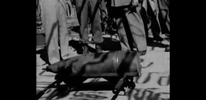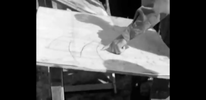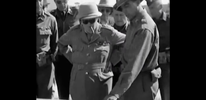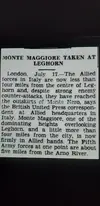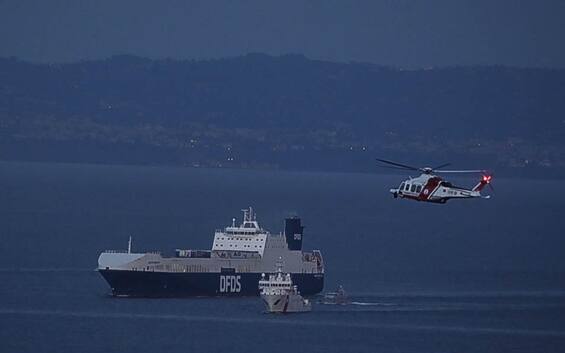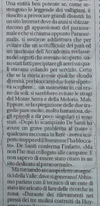LITTLE DOCTOR
Member
UN ELEFANTE CON PROBOSCIDE DI PIETRA ED UN OBESO CON SIGARO, MA PUR SEMPRE PACHIDERMI
Dunque bisognava seguire l’elefante? E in che modo? Forse non fu solo un caso che il diretto superiore del Caporale, durante la missione in Pantelleria, il sergente maggiore Orlando, avesse portato “fuori ordinanza” un’intera attrezzatura da pesca di alto fondale, compreso un gommone dotato di motore. Il sergente maggiore, appassionato di pesca subacquea, durante le sue immersioni nelle profonde acque dell’isola, si faceva accompagnare dal Caporale che prestava assistenza in superfice dal gommone. Ma in una notte di luna piena, lo stesso Caporale prese in “prestito” l’intero equipaggiamento subacqueo per tentare di seguire l’elefante, ma nella fretta non si accorse che le bombole di ossigeno erano quasi esaurite, ma questa è un’altra storia…
Storie e ancora storie, che si intrecciano e si completano a vicenda fino a formare un’enorme spirale dove tutte le informazioni si congiungono per completare il capitolo finale, proprio come quando gli elefanti, giunti alla fine del loro percorso, si dirigono verso i loro cimiteri, depositando le loro ossa così come le loro memorie. È quindi giunto il momento di narrare un’altra memorabile storia da aggiungere alla grande spirale del tempo. Per far questo dobbiamo ritornare indietro fino alla seconda guerra mondiale, precisamente al 19 agosto del 1944. Ormai è cosa nota la vicenda vissuta da Leonardo da Vinci durante la sua escursione da Nugola fino al monastero della Sambuca fatta in occasione del suo soggiorno a Livorno. Tutt’oggi appassionati e ricercatori tentano di ripercorrere le sue orme nella speranza di scoprire ciò che Leonardo andava cercando. Studiosi o semplici curiosi, tutti accomunati dalla stessa passione: la ricerca di tutto ciò che è esoterico. Fu proprio sul finire della seconda guerra mondiale, come già ho citato, che un personaggio di fama mondiale volle personalmente venire a Livorno per verificare la veridicità della leggenda di Leonardo da Vinci. Leggenda che aveva appreso quando faceva parte di circoli esoterici essendo membro dell’allora “Ancient order of the druids”. Questo importante personaggio, oltre ad essere un noto politico e stratega militare, era pure uno storico sempre alla ricerca di indizi che potessero confermare la propria discendenza italiana dalle famiglie fiorentine degli Strozzi e Guicciardini. Discendenza che gli aveva portato come secondo nome quello di Leonard, dal momento che i suoi avi erano appassionati e affascinati dalla figura di Leonardo da Vinci. Questo personaggio di cui sto parlando era Winston Leonard Churchill. Dopo essere atterrato al campo di atterraggio allestito dagli alleati a Cecina, si spostò tra Vada e Castiglioncello prima di arrivare a Nugola dove ebbe in programma un’ispezione ad una postazione di obice prima di inoltrarsi nel fiume Ugione, dove spense il mozzicone del suo sigaro durante il tragitto che lo avrebbe portato al monastero della Sambuca, ma questa è un’altra storia… per il momento posso solo mostrare alcune foto in allegato che ritraggono Churchill durante la sua ispezione alla postazione di tiro a Nugola, necessarie a descrivere in parte ciò che ho appena narrato, ma che non posso ancora completamente svelare dato che dobbiamo concedere il tempo ad un Caporale di scegliere quale spirale voglia cavalcare.
Storie e ancora storie, che si intrecciano e si completano a vicenda fino a formare un’enorme spirale dove tutte le informazioni si congiungono per completare il capitolo finale, proprio come quando gli elefanti, giunti alla fine del loro percorso, si dirigono verso i loro cimiteri, depositando le loro ossa così come le loro memorie. È quindi giunto il momento di narrare un’altra memorabile storia da aggiungere alla grande spirale del tempo. Per far questo dobbiamo ritornare indietro fino alla seconda guerra mondiale, precisamente al 19 agosto del 1944. Ormai è cosa nota la vicenda vissuta da Leonardo da Vinci durante la sua escursione da Nugola fino al monastero della Sambuca fatta in occasione del suo soggiorno a Livorno. Tutt’oggi appassionati e ricercatori tentano di ripercorrere le sue orme nella speranza di scoprire ciò che Leonardo andava cercando. Studiosi o semplici curiosi, tutti accomunati dalla stessa passione: la ricerca di tutto ciò che è esoterico. Fu proprio sul finire della seconda guerra mondiale, come già ho citato, che un personaggio di fama mondiale volle personalmente venire a Livorno per verificare la veridicità della leggenda di Leonardo da Vinci. Leggenda che aveva appreso quando faceva parte di circoli esoterici essendo membro dell’allora “Ancient order of the druids”. Questo importante personaggio, oltre ad essere un noto politico e stratega militare, era pure uno storico sempre alla ricerca di indizi che potessero confermare la propria discendenza italiana dalle famiglie fiorentine degli Strozzi e Guicciardini. Discendenza che gli aveva portato come secondo nome quello di Leonard, dal momento che i suoi avi erano appassionati e affascinati dalla figura di Leonardo da Vinci. Questo personaggio di cui sto parlando era Winston Leonard Churchill. Dopo essere atterrato al campo di atterraggio allestito dagli alleati a Cecina, si spostò tra Vada e Castiglioncello prima di arrivare a Nugola dove ebbe in programma un’ispezione ad una postazione di obice prima di inoltrarsi nel fiume Ugione, dove spense il mozzicone del suo sigaro durante il tragitto che lo avrebbe portato al monastero della Sambuca, ma questa è un’altra storia… per il momento posso solo mostrare alcune foto in allegato che ritraggono Churchill durante la sua ispezione alla postazione di tiro a Nugola, necessarie a descrivere in parte ciò che ho appena narrato, ma che non posso ancora completamente svelare dato che dobbiamo concedere il tempo ad un Caporale di scegliere quale spirale voglia cavalcare.
English version
AN ELEPHANT WITH A STONE TRUNK AND AN OBESE MAN WITH A CIGAR, BUT STILL PACHYDERMS
AN ELEPHANT WITH A STONE TRUNK AND AN OBESE MAN WITH A CIGAR, BUT STILL PACHYDERMS
So was it necessary to follow the elephant? And in what way? Perhaps it was not just a coincidence that the Corporal's direct superior during the Pantelleria mission, sergeant major Orlando, had brought "out of order" an entire deep-sea fishing outfit, including an inflatable boat equipped with a motor. The sergeant major, an avid spearfisher, during his dives in the deep waters of the island, would be accompanied by the Corporal who provided surface assistance from the dinghy. But on a full moon night, the same Corporal "borrowed" his entire diving equipment to try to follow the elephant, but in his haste he did not notice that the oxygen tanks were almost exhausted, but that is another story...
Stories and more stories, intertwining and complementing each other until they form a huge spiral where all the information comes together to complete the final chapter, just as when elephants, having reached the end of their journey, head for their graveyards, depositing their bones as well as their memories. It is therefore time to tell another memorable story to add to the great spiral of time. To do this we must go back as far as World War II, specifically to August 19, 1944. By now it is well known what Leonardo da Vinci experienced during his excursion from Nugola to the Sambuca monastery made during his stay in Livorno. To this day enthusiasts and researchers attempt to retrace his footsteps in the hope of discovering what Leonardo was looking for. Scholars or simply curious people, all united by the same passion: the search for all that is esoteric. It was right at the end of World War II, as I have already mentioned, that a world-famous person personally wanted to come to Livorno to verify the veracity of the legend of Leonardo da Vinci. Legend that he had learned when he was part of esoteric circles being a member of the then "Ancient order of the druids." This important personage, besides being a well-known politician and military strategist, was also a historian who was always looking for clues that could confirm his Italian descent from the Florentine families of Strozzi and Guicciardini. A descent that had brought him as a middle name that of Leonard, since his ancestors were passionate and fascinated by the figure of Leonardo da Vinci. This character I am talking about was Winston Leonard Churchill. After landing at the landing field set up by the Allies at Cecina, he moved between Vada and Castiglioncello before arriving at Nugola where he was scheduled to inspect a howitzer emplacement before going into the Ugione River, where he extinguished the butt of his cigar on the way to the Sambuca monastery, but that is another story... For the moment I can only show some attached photos depicting Churchill during his inspection of the firing position at Nugola, which are necessary to describe in part what I have just narrated, but which I cannot yet fully disclose since we must allow time for a Corporal to choose which spiral he wants to ride.
Stories and more stories, intertwining and complementing each other until they form a huge spiral where all the information comes together to complete the final chapter, just as when elephants, having reached the end of their journey, head for their graveyards, depositing their bones as well as their memories. It is therefore time to tell another memorable story to add to the great spiral of time. To do this we must go back as far as World War II, specifically to August 19, 1944. By now it is well known what Leonardo da Vinci experienced during his excursion from Nugola to the Sambuca monastery made during his stay in Livorno. To this day enthusiasts and researchers attempt to retrace his footsteps in the hope of discovering what Leonardo was looking for. Scholars or simply curious people, all united by the same passion: the search for all that is esoteric. It was right at the end of World War II, as I have already mentioned, that a world-famous person personally wanted to come to Livorno to verify the veracity of the legend of Leonardo da Vinci. Legend that he had learned when he was part of esoteric circles being a member of the then "Ancient order of the druids." This important personage, besides being a well-known politician and military strategist, was also a historian who was always looking for clues that could confirm his Italian descent from the Florentine families of Strozzi and Guicciardini. A descent that had brought him as a middle name that of Leonard, since his ancestors were passionate and fascinated by the figure of Leonardo da Vinci. This character I am talking about was Winston Leonard Churchill. After landing at the landing field set up by the Allies at Cecina, he moved between Vada and Castiglioncello before arriving at Nugola where he was scheduled to inspect a howitzer emplacement before going into the Ugione River, where he extinguished the butt of his cigar on the way to the Sambuca monastery, but that is another story... For the moment I can only show some attached photos depicting Churchill during his inspection of the firing position at Nugola, which are necessary to describe in part what I have just narrated, but which I cannot yet fully disclose since we must allow time for a Corporal to choose which spiral he wants to ride.
Last edited:


